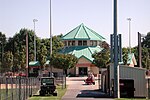Expo Center station

Expo Center is a light rail station on the MAX Yellow Line in Portland, Oregon, United States. It is the last stop northbound on the Interstate MAX extension. This station is a large park-and-ride station located on the grounds of the Portland Expo Center. It is set up as a modified side platform station, with the two platforms serving three tracks. The extra track allows the storage of an overflow train for events at the Expo Center. The 300 park-and-ride spaces are free for commuters arriving before 10 am on weekdays for a maximum 24 hours. At all other times, drivers must pay the Expo Center's usual $7–8 parking fee. Although tracks and electrification end directly inside the station, it is designed to allow a future northbound extension (to Vancouver, Washington) to be easily constructed. Both the landscaping and the artwork at the station are themed in a Japanese style. This recalls the temporary Civilian Assembly Center that existed here during the early days of World War II, which processed Japanese-Americans upon the enforcement of Executive Order 9066.
Excerpt from the Wikipedia article Expo Center station (License: CC BY-SA 3.0, Authors, Images).Expo Center station
North Marine Drive, Portland Kenton
Geographical coordinates (GPS) Address Nearby Places Show on map
Geographical coordinates (GPS)
| Latitude | Longitude |
|---|---|
| N 45.605555555556 ° | E -122.68555555556 ° |
Address
Expo Center
North Marine Drive
97217 Portland, Kenton
Oregon, United States
Open on Google Maps










